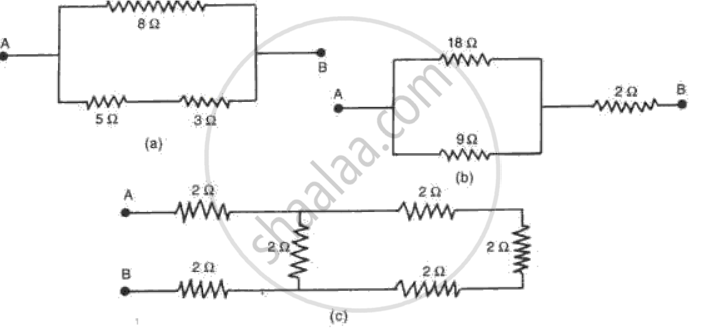Advertisements
Advertisements
प्रश्न
How will you conclude that the same potential difference (voltage) exists across three resistors connected in a parallel arrangement to a battery?
उत्तर
- Take three resistors R1, R2 and R3 and connect them in parallel arrangement as shown in the diagram.

- Connect voltmeter in parallel to measure the potential difference across the combination.
- Now measure the potential difference across the resistor R1 by connecting the voltmeter across it.

- Again, measure the potential difference across the resistor R2 by connecting the voltmeter across it.
- Again, measure the potential difference across the resistor R3 by connecting the voltmeter across it.
- Tabulate all the readings.
It is observed that potential difference reading will be same in all the three cases. This shows that the same potential difference exists across three resistors connected in parallel arrangement to a battery.
APPEARS IN
संबंधित प्रश्न
The values of current I flowing in a given resistor for the corresponding values of potential difference V across the resistor are given below:
| I (amperes) | 0.5 | 1.0 | 2.0 | 3.0 | 4.0 |
| V (volts) | 1.6 | 3.4 | 6.7 | 10.2 | 13.2 |
Plot a graph between V and I and calculate the resistance of that resistor.
Define the unit of resistance (or Define the unit "ohm").
A current of 200 mA flows through a 4 kΩ resistor. What is the p.d. across the resistor?
In the circuit shown below:

The potential difference across the 3 Ω resistor is:
What is the combined resistance of each of the networks between A and B shown in fig. ?

A V-I graph for a nichrome wire is given below. What do you infer from this graph? Draw a labelled circuit diagram to obtain such a graph.

Five resistors of different resistances are connected together as shown in the figure. A 12 V battery is connected to the arrangement.

Calculate:
(i) the total resistance in the circuit
(ii) the total current flowing in the circuit.
A battery of 10 volt carries 20,000 C of charge through a resistance of 20 Ω. The work done in 10 seconds is:
100 J of heat is produced each second in a 4 Ω resistor. The potential difference across the resistor will be:
What is the measure of the work done on the unit positive charge to bring it to that point against all electrical forces?
